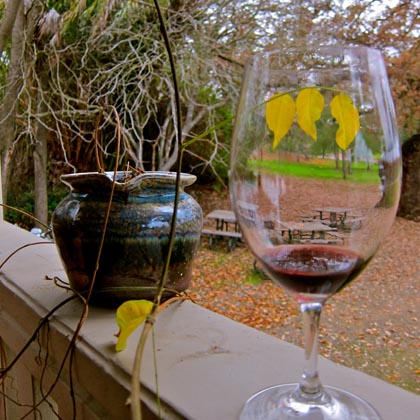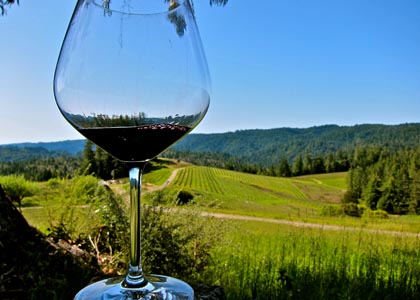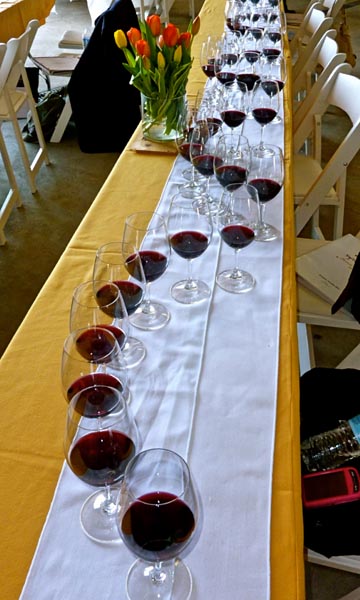Letters from Lodi
An insightful and objective look at viticulture and winemaking from the Lodi
Appellation and the growers and vintners behind these crafts. Told from the
perspective of multi-award winning wine journalist, Randy Caparoso.
Right glasses & temperatures matter
21 oz. tulip shaped glass, ideal for Zinfandel & Cabernet Sauvignon
Wine glasses make a difference
Aside from choosing what wine to drink, there is probably no choice as key to your enjoyment of wine as your selection of wine glass.
Everyone knows that wine glasses properly come with a stem, are crystal clear for visual pleasure, and are curved inward to allow the nose to better enjoy the aromas collecting just below the rim. But size and shape also matter. Generally speaking, white wines taste best in 12 to 14 oz. glasses in the graceful shape of a tulip. But for red wines, you can use the same 12 oz. tulip as you do for whites, but they won’t taste nearly as good as in a bigger, 19 22, 25 or even 30 oz. glass.
Classic 25 oz. bowl shaped "Burgundy" glass
Why? Red wines, being denser and heavier than white wines, need a larger surface area to create the vapors (through swirling) that increase aromatic qualities. And the more aromas you smell, the more flavors you taste on the palate. A simple way to test this is by doing a side-by-side comparison. Taste a red wine in a small, 8 to 12 ounce glass next to the same red wine in a 19 to 25 oz. glass. If you don’t have different glasses at home, try it in a fine restaurant where they often have smaller glasses for white wines and larger ones for red wines. I guarantee you’ll taste the difference.
Although elongated tulip shapes at least 19 oz. in size do well for most reds (like Cabernet Sauvignon, Merlot and Zinfandel), many red wine lovers go even further, preferring round, bowl shaped glasses holding up to 25-30 ounces. The classic “Burgundy” shape is more of a round bowl, and is especially preferred for wines made from Pinot Noir because it provides even larger surface areas for vapors to work off of, thus emphasizing perfume. What the bowl shape also does is allow red wine to enter the palate closer to the tip of the tongue (as opposed to the center), and it’s at the tip of the tongue where many of your taste buds sensitive to sensations of sweetness are located. So with bowl shapes, your red wines end up tasting softer and fruitier; especially good if you’re drinking more expensive, heavy red wines that are loaded down with hard, even bitter, tannins. The idea is to be able to taste a big red’s fruitiness before its tannins.
Smaller 12 oz. tulips are more ideal for whites and pinks
Riedel was a pioneer of many of these variations of crystal quality wine glasses, priced retail anywhere from $10 to $75 per stem; other prestige quality, albeit less costly, brands of wine glasses include Spiegelau, Ravenscroft, and Schott Zwiesel. There are plenty of other good sized, economically priced alternatives available online and many kitchen and wine supply stores.
The bottom line: life is too short for lousy wine glasses!
Serving temperatures really matter
White, pink and sparkling wines are traditionally served chilled (38 to 40 degrees Fahrenheit), and red wines at “room temperature.” But keep in mind that ideal room temperature for wines is not the same as for human beings; ideally, it is between 65 and 72 degrees — significantly cooler than a typical summer day. Be as it may, most red wines are not at their best served well chilled like white wines because their higher tannin and weight lock in aroma and flavor if served at icy temperatures.
White, pink, and sparkling wines, of course, are simply more refreshing served well chilled, whether from a bed of ice or after at least two hours in a refrigerator. Cooler temperatures tend to accentuate aromas and flavors of fruit, which is what these types of wines are all about.
Softer, fruit driven red wines, such as Beaujolais from France and many Pinot Noirs and easier drinking Zinfandels and Tempranillos, are probably best enjoyed even closer to 60 to 65 degrees (if stored in a room above 72 degrees, chilled 30 to 60 minutes in the refrigerator) than heavier red wines such as Cabernet Sauvignon, Merlot, Syrah and red Zinfandels.
But even the heaviest red wines are not so enjoyable if served too warm (80 degrees or higher). “Hot” temperatures tend to accentuate a big red’s alcohol and tannin, making the wine taste coarse or rough, and detracting from the natural fruit qualities and complexities winemakers work so hard to produce.
The ideal situation, of course, is to bring a red wine out from a room, cellar or cabinet kept at 55 to 59 degrees (the ideal storage temperatures) a few minutes prior to service. Once brought into a normal room temperature, a red wine’s optimal serving temperature is naturally while just sitting on the table.
Our next Wine 101: How wines and foods are matched



